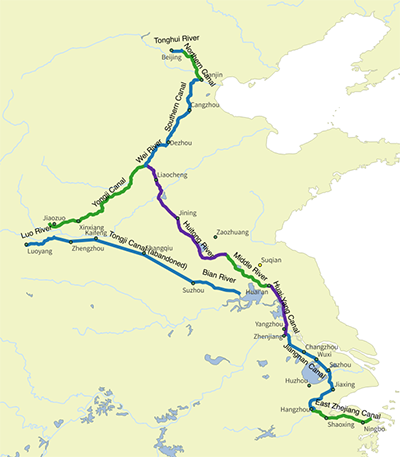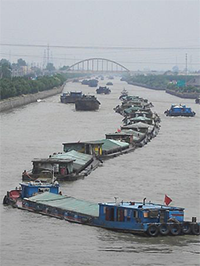China's Grand Canal
China's Grand Canal is the world's longest such waterway, stretching 1,104 miles through the interior of the country, linking Beijing in the north and Hangzhou further south, along the way running through eight provinces. Along the way are 60 bridges and 24 locks. At its widest, the Canal, a UNESCO World Heritage site, is 131 feet wide. 
During the Spring and Autumn Period, about 480 B.C., King Fu Chai of Wu initiated construction. One early part, the Han Gou Canal, connected the Huai River and the Yangtze River. Connecting the Bian River and the Yellow River was another early part, the Hong Gou Canal. Emperor Yang of the Sui Dynasty gave official impetus to what is now the Grand Canal, connecting existing canals and adding his own bit, so that the Canal in 610 connected Beijing and Hangzhou. Large parts of the waterway were built on flat ground; builders needed to add levees to help the canal travel along higher ground. In the very early days, teams of oxen or horses or even men pulled ships along the waterway.  Controlling passage along the Canal were a number of locks, and some emperors in subsequent years would sail along in order to inspect those locks. The Song Dynasty in the late 10th Century incorporated the pound lock, with gates on either end; augmenting travel before then were a number of flash locks, which incorporated a sudden rush of water in order to flush a boat through a gate. Official government communications often traveled by boat, along the Grand Canal, as did grain and other food sources and a number of trade items, most notably porcelain and silk. The internal nature of the canal made it more attractive than travel along the coasts, where ships could be subject to natural threats like winds and storms and manmade threats like enemies. More importantly to preserving civil order, the Canal facilitated the relatively rapid transport of armed forces as well. In the later part of the Yuan Dynasty, workers added to the Canal, bypassing the older route to Luoyang and resulting in direct travel to Beijing. 
As popular as the Grand Canal was, however, it fell into disrepair. Ming Dynasty rulers in the early 15th Century ordered a large reconstruction of the Canal, including increasing the water depth and adding locks and reservoirs. A large-scale flood of the Yellow River in 1855 damaged the Canal, and some of that damage remains (although subsequent restorations in the 1950s and the 2000s shored up much of the trouble areas). Slave and enforced labor created and rebuilt the Grand Canal:
|
|




